 |
[2]How to play (simple rules)

· If you play on an intersection, basically you can play anywhere you want to.
· You are free to play where you want to, but, of course, the values of the points differ. If you come to understand the differences, that means that you have made considerable progress.
· At first, you may be confused about where to play, but basically you can play anywhere. As you can see in Dia. 2, the players take turns to play. You can play anywhere, but the development in this diagram might be played by professionals. |
 |
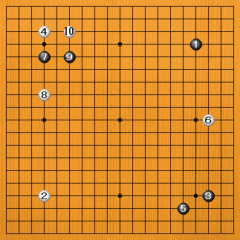
Dia. 2 |
 |
· You could also play as in Dia. 3, but professionals and strong players would never play like this. You'll come to understand the reasons gradually, but let's give some simple reasons. The most unnatural move here is White 4. Places like this on the edge of the board are usually low in value, so they are rarely played at an early stage of the game. Black 9 is also funny. Black has stones at 3 and 7, but linking them up immediately with 9 is inefficient. You may not completely understand the meaning of this yet, but there's no need to worry. You will understand little by little. If you just vaguely remember that 'it's better not to play on the edge at the beginning' and 'lining up stones in a row is inefficient', that's good enough.
· The only thing is that there are lots of exceptions in Go. A move may have low value now, but when the game progresses and the shape changes, such a move may become the most important point. There are many proverbs and sayings expressing common sense that are useful in acquiring the knack of playing Go, but don't forget that nothing is absolute. Values change according to the time and place, so you have to be flexible. That's one of the features of the game and what makes it interesting. |
 |
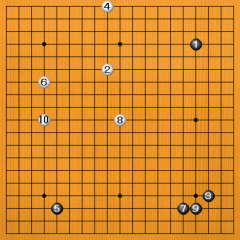
Dia. 3 |
 |
|
· (Application) Let's have a look at Dia. 4. Which side is playing better, Black or White? Detailed reasons are not yet necessary. How does it feel to you? Doesn't Black's position feel like a comfortable one? In contrast, White is biased towards one area on the edge of the board. In Go, it's important to play in a free and relaxed way, so Black's play is better. With 1 to 5, Black occupies different areas, and he is using the Go board freely. However, with 2 to 10, White's stones are all focused on one area, and in that area he's playing just on the edge. His position feels cramped and far from relaxed. If you can just vaguely understand this feeling, that's good enough. You learn many aspects of Go intuitively. |
 |
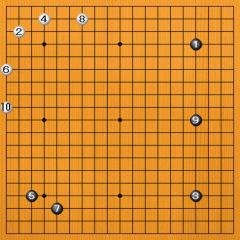
Dia. 4 |
 |
· The Go board has 19 horizontal and 19 vertical lines, but a 9x9 board is easier for beginners. In this text, we will mainly use a 9x9 board.
· The way you play doesn't change on a 9x9 board: it's the same game. In Dia. 5, Black plays first. In texts, the stones are often numbered so that we know the order in which the moves were played. If the play continues in a new diagram, there will be a message:'go to the next diagram'. |
 |
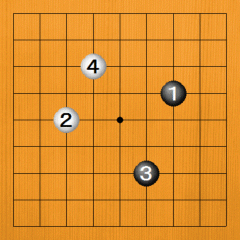
Dia. 5 |
|
Dia. 6 continues from Dia. 5. The stones played in Dia. 5 are shown here just as black and white stones, and the next moves are shown as Black 1 and White 2. The advantage of this is that we don't have to use big numbers, so the diagram is simpler. This method might confuse you at first, but you will get used to it as you go along. |
 |
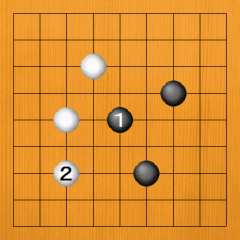
Dia. 6 |
|
 |